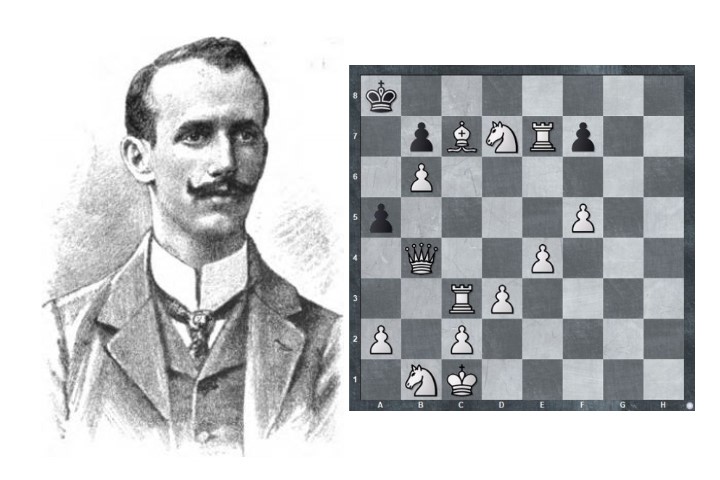


Usually we talk about horrible events that happened long ago, but this time many emotions of still living victims and their relatives might come up. For this, we apologize.
What do you think when you talk about September 11? For many of us, that will most likely be about the horrible events that happened 20 years ago in the United States. Possibly the 1973 Coup d’état in Chile, which brought unspeakable horrors to the country. If you are knowledgeable about endgame studies, you might know that the birthdate of a very famous idea dates from a century ago.
 The saddening coincidences about events on 9/11 do not end here. Although small on the greater scale of events, a tragic loss for chess happened at this date in the early 20th century: on 11 September 1913, the Austrian Julius Perlis (born on 19 January 1880) went missing in the Alps and never returned. Only shortly among the strongest players, he was of world-class level at times, but not consistent enough to win big tourneys, and as such San Sebastián 1912 was among his biggest successes: he got 5th place after drawing twice against Rubinstein (1st place) and once against Nimzowitsch (2nd), against whom Perlis even won the other game.
The saddening coincidences about events on 9/11 do not end here. Although small on the greater scale of events, a tragic loss for chess happened at this date in the early 20th century: on 11 September 1913, the Austrian Julius Perlis (born on 19 January 1880) went missing in the Alps and never returned. Only shortly among the strongest players, he was of world-class level at times, but not consistent enough to win big tourneys, and as such San Sebastián 1912 was among his biggest successes: he got 5th place after drawing twice against Rubinstein (1st place) and once against Nimzowitsch (2nd), against whom Perlis even won the other game.
Who knows what could have become of the young attorney if his results were more stable, and he could have lived on...? Of his three endgame studies (all in the Wiener Schachzeitung, February 1901), sadly none is particularly interesting today. One of them forcibly builds a checkmate, another has a promoted bishop in the initial position (which could be resolved by declaring it a Chess-960 study), and the third is refuted. As a small tactical exercise, the one with the promoted bishop or Chess-960 is given to readers for solving.
As the solution is easy to find, a selfmate by Perlis and his uncle, equally easy to figure out for experienced selfmate-solvers, is replayable below.
After all the sadness, one happy event is to be celebrated from 100 years ago, when the Deutsch-Österreichische Tageszeitung published a very famous endgame study by Richard Réti. For a long time, the exact first source was unclear, and it was declared as it had appeared in 1922. Some research found the original source.
The Réti manoeuvre shows that geometry on the chessboard is vastly different from a Euclidean two-dimensional plane. A straight line from A to B is as long as a diagonal line from A halfway to B but into a direction that leads away, and then from that point to B, if A and B are on the same rank or file. In Euclidean geometry, the distance from h8 to h2 is 6 units, whereas the distance from h8 to e5 to h2 is six times the square root of 2 — i.e. nearly 8.5 units. On the chessboard geometry, both are equally long with 6 units each.
1.Kg7 h4 2.Kf6 Kb6 3.Ke5 h3 4.Kd6 or 3.-K:c6 4.Kf4 draw on the chessboard, but would lose without that special geometry — the king from a6 to c6 needs two units of time, i.e. moves; the pawn from h5 to h2 needs three units of time. White — starting — has six units of time at his disposal to get from h8 to h2 via e5. Without the chessboard geometry, White would inevitably lose time by moving diagonally, or would be unable to catch up with the pawn on a straight line. By the time the h4-pawn reaches h2, White also reaches h2 on the chessboard, but he would be far away without the time dilation on the diagonal.
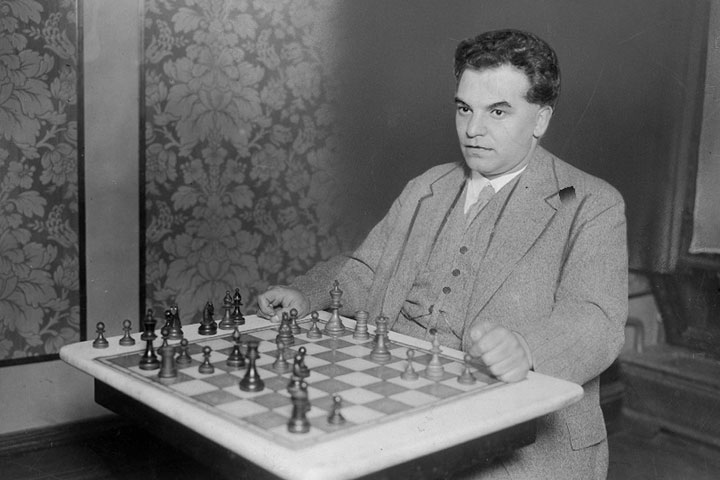
Richard Réti | Photo: Ernst & Cesanek, Public domain via Wikimedia Commons
If we talk about three-dimensional non-Euclidean spaces, we usually see this in the context of video games that use either tricks (examples include Narbacular Drop and its successor, the Portal series, where two points in space can be connected to each other via portals; or in Antichamber, where such portals are used by the developer to create optical and spatial illusions), or outright hyperbolical or spherical geometry, which both create interesting effects such as allowing to use the sum of the angles of a triangle to find out how big it is, all of which would be impossible on a Euclidean two-dimensional plane.
Of course, the Réti manoeuvre would look very different there as well. In the most extreme case, such as the fairy chess condition “vertical cylinder”, the eighth and first rank are connected, so a move like Kh8-h1 is legal on a normal board. Of course, if you could set portals anywhere on a board as you wish, you’d be able to promote a pawn from c6 immediately, but that is not the point.
A small endgame study was posted on the internet by one person who goes by ‘William chess dude# 6824’, according to the description under the source I found on YouTube. We assume this is a name on the communications platform Discord. His endgame study is easy but amusing (but with a dual minor).
This reminds me very much of the style of another Austrian attorney: Alois Wotawa. Wotawa worked as a judge and prosecutor for many years, but I still have to fully read his biography Und wird hiefür zum Tode..., which I bought used a few years ago. Chess players might rather know his 150 Endspielstudien.
My favourite Wotawa study uses a different style, but might have been presented here before.
On 18 July 2021 a small but beautiful meeting was held with Klaus Rubin (see our December 2016 column) and Martin Minski, who supplied not only a good sense of choosing local restaurants in your author’s new hometown of Güstrow but also material for this column. Rubin provided the German edition of a book that I think I had in Russian: Schachstudien der Weltmeister by Anatoly Karpov and Evgeny Gik. Coincidentally, an entire chapter in their book is about the Réti manoeuvre.
As I don’t speak Russian, the following interesting episode only then became known to me. The following endgame is widely known, but there is a detail that is lesser known.
Usually it is reported that White played 1.Kc2?, hoping for the variation 1.-Kf3 2.Ne6 e2 3.Nd4+, and White catches the pawn and draws. Black played 1.-Kg3 and White resigned. It always baffled me that a world champion contestant can miss such a simple move. The entire variation is so obvious that it can be easily avoided.
While one part of the assumption is true, that 1.Ne6 and 2.Nd4 would have drawn, later I read somewhere — I forgot where — that White had accidentally touched the king and thus moved it to c2. That is however not the end of the story.
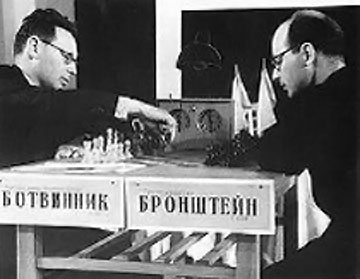
Let us assume White touched his king. Knowing the knight can reach d4 and give the check in two moves, he would certainly play 1.Ka4?. While not talking about touching the king, the book reveals that indeed White set — unknowingly — a trap with his king move. He must have seen that he will lose, but played 1.Kc2 to provoke 1.-Kf3. As it is, 1.-Kf3 2.Ne6 e2 3.Nd4+ Kf2 4.Nxe2 Kxe2 is won for Black. Bronstein’s second Wainstein wrote in Improvisation in der Schachkunst (we believe that would be in Russian, but translator Kohlmeyer translated the title) that Black wins with this variation. However, after 1.-Kf3 there is a way for White to draw: as Botvinnik pointed out in his 1985 book Analytische und kritische Arbeiten - 1942-1956, White draws with (after 1.Kc2? Kf3?a) 2.Nf7!! e2 3.Ne5+, and he has gained time compared to the other variation.
Despite chess composition being open and inviting to everyone, very few women actually seem to compose. Germany once had a rising star in Melanie Ohme, who became one of the best players of our country (WGM today) and married her countryman Nikolas Lubbe (IM today), himself a great chess player, taking his last name. Analysing an endgame, Melanie Lubbe found an incredible move in her game against Aljoscha Feuerstack from Lüneburg 2019. Together with Martin Minski, she created an endgame study based on the paradoxical idea. We reproduce this co-composition in the replayable entries below.
Some readers might remember the pawn position from Das 1x1 des Endspiels, but the endgame study here is vastly different from the game between Demberger and Hecht — although the material is similar. It is included in the replayable entries, as I found a new (?) way to draw in it after the moves that were thought to be winning. Asking Karsten Müller for assistance, he didn’t tell me of an earlier analysis of this endgame, but pointed out a similar check with a different idea (allowing a skewer) that is the only drawing move in a game between Radjabov and Vachier-Lagrave last year. It is interesting to compare the optically similar endgames.
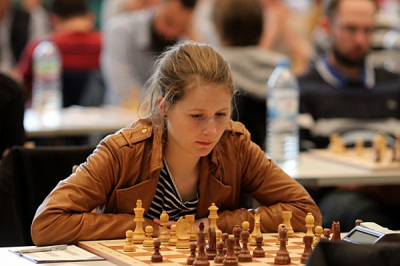
Melanie Lubbe at the GRENKE Open 2017
We hope to see more endgame studies by Melanie Lubbe, or other women. Chess historians know that one of the best-regarded composers was a woman: Edith Baird. Contemporary female composers and organizers include, among others, Julia Vysotska (Julia's Fairies) who is a leading fairy chess expert, Sally Lewis (related to Tony Lewis), and Herr Gabriel Baumgartner, the alias of Odette Vollenweider, whose recently passing we greatly mourn.
Dijan Kostadinov wrote an article on the subject a few years ago. I don’t possess the book Queens of chess composition, which lists over a hundred women (Part 1 | Part 2).
I was born in March 1986. The New In Chess issue of that month lists two chess problems by then-11-year-old Zsófia Polgár. They were reproduced on the specialized MatPlus forum by Joose Norri, so we can offer them to readers to solve — the twomover should not be too hard, while the threemover might require a few mintues. The solutions are at the end of this article.

Judit and Sofia Polgar in Hamburg, 1989 | Photo: Frederic Friedel
Of course, one question is left to be answered: who is the highest-ranked female endgame study composer? If over-the-board titles count as well, the answer (World Champion Alexandra Kosteniuk) is included in the replayable studies below. Why at the end of the listed studies? Of course, we save the best (player) for last!
Your author doesn’t know of any other over-the-board world champion who got clear first place at a study tourney, let alone at the time they held the title. Smyslov once (70 years after he started composing) shared a 1st/2nd prize, but won several special prizes. Of course, I came to the conclusion that while prizes are nice, reprints of endgame studies matter more, and Smyslov greatly won there. So, we have a great (chess) author and a great singer as the queen and king of world champions who are also endgame study composers.
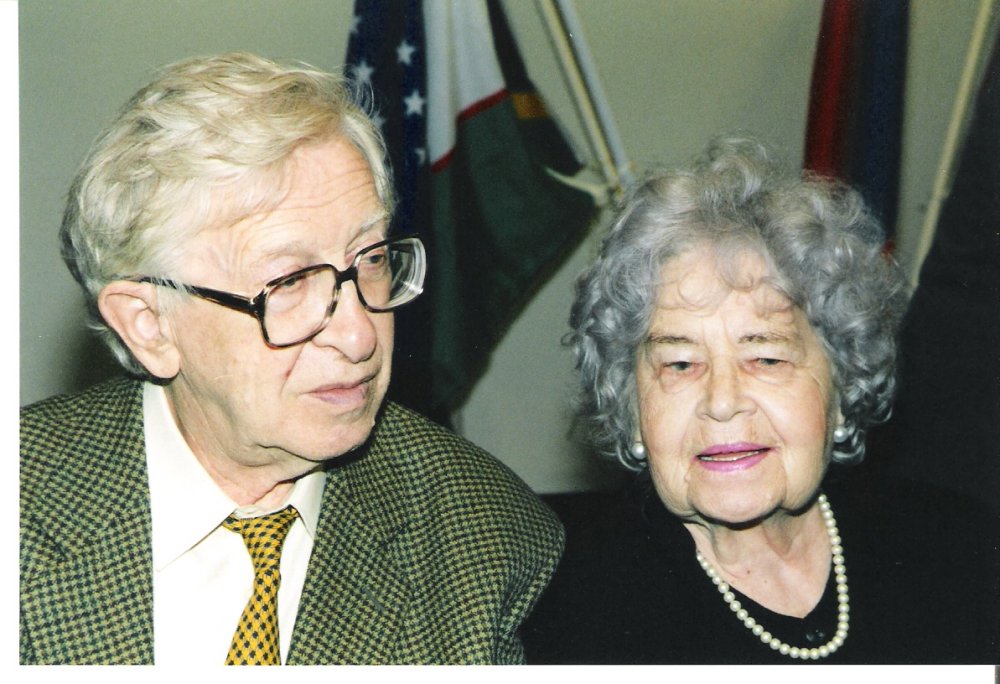
Vasily Smyslov with wife Nadezhda
While preparing this article, I stumbled upon a curiosity. Pogosyants removed two pawns from a well-known endgame study to create another well-known endgame study (which I had thought to be much older). The beginning of the new study is similar, however. Possibly, this illustrates best how Pogosyants was inspired by classical endgame studies to create his own ideas. Of course, I can’t prove that he used the old study as a template, but even if he didn’t, it is a fun coincidence. They are replayable below.
Réti’s idea inspired many composers to draw their conclusions from the geometry on the chessboard. Mathematical rules can be found to extend a classical pawn square, as it is the case from g5 to g7 in the Réti study. One aspect of this strange geometry is that the squares e5 and e6 require the same distance: a king on b2 would lose despite being able to reach e5 in three moves, as he would need four moves to reach e6. On the other hand, the pawn square does extend to b4, so a king on a3 can still draw. Granted, now the h-file is further away than from g7-f6-e5, but Black will have to use his two king moves earlier. Réti himself apparently showed this in 1921 (according to Karpov and Gik’s book) with the king on a4, but the database lists this as having been found in 1922. Do readers know the earlier source?
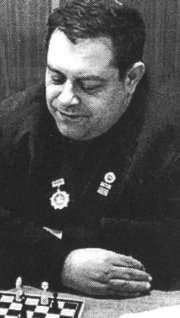 A century of composers has been inspired by a small study with only four pieces. Among them was Ernest Pogosyants [pictured], whose final entry for this month combines two endgame study ideas that lie not only a quarter of a century but also half a point apart: Troitzky’s 1895 checkmate with king and bishop combines with Réti's geometry at the cost of a rather brutal introduction which is justified due to the synthesis of the ideas that otherwise would have been impossible to create.
A century of composers has been inspired by a small study with only four pieces. Among them was Ernest Pogosyants [pictured], whose final entry for this month combines two endgame study ideas that lie not only a quarter of a century but also half a point apart: Troitzky’s 1895 checkmate with king and bishop combines with Réti's geometry at the cost of a rather brutal introduction which is justified due to the synthesis of the ideas that otherwise would have been impossible to create.
In the year 1988, Pogosyants was awarded the title of Grandmaster for Chess Compositions, with over 4,000 of his works published, which means only one percent made it into the FIDE Album. Pogosyants published his studies everywhere, and yet supposedly had 2,000 unpublished compositions (and double as many poems and aphorisms) when he died in 1990 — at only 55 years of age. Frightening is that those works, to my knowledge, remain unpublished. As such, our article also ends with great sadness, just like it began...
Click or tap an entry in the list to switch positions
You probably know that you can move pieces on our replay boards to analyse and even start an engine to help you. You can maximize the replayer, auto-play, flip the board and even change the piece style in the bar below the board.
At the bottom of the notation window on the right there are buttons for editing (delete, promote, cut lines, unannotate, undo, redo) save, play out the position against Fritz and even embed the ChessBase game viewer on your website or blog. Hovering the mouse over any button will show you its function.

World Federation for Chess Composition (www.wfcc.ch)
| Advertising |